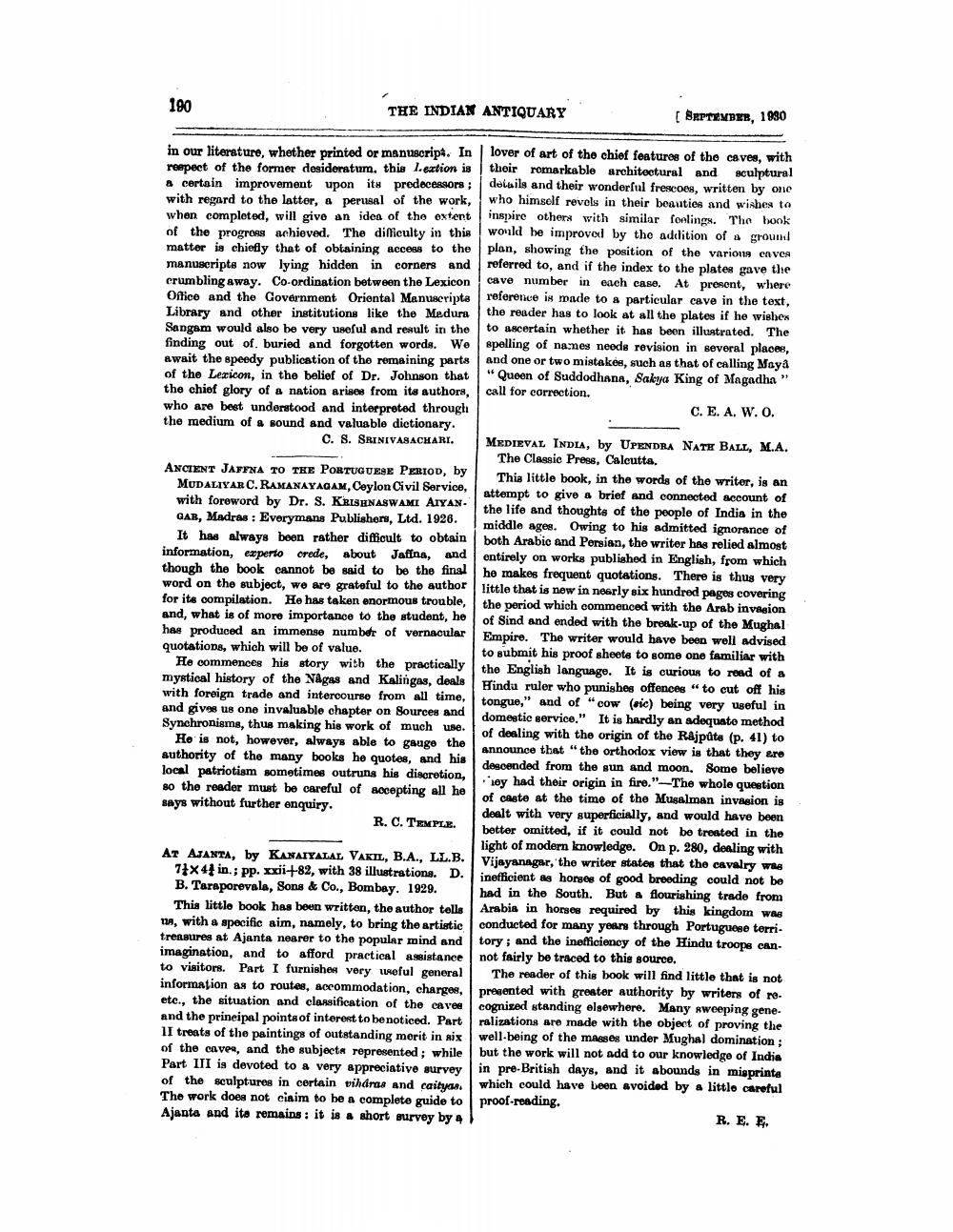________________
190
THE INDIAN ANTIQUARY
[ BPTEMBER, 1990
in our literature, whether printed or manuscrip. In lover of art of the chief features of the caves, with reepect of the former desideratum, this l.extion is their romarkable architectural and sculptural & certain improvement upon itu predecessors; details and their wonderful frescoes, written by one with regard to the latter, & perusal of the work,
the latter. A perual of the work, who himself revels in their beauties and wishes to when completed, will give an idea of the oxtent inspire others with similar foelings. The hook of the progroas achieved. The dificulty in this would be improved by the addition of a ground matter is chiefly that of obtaining access to the plon, showing the position of the various caves manuscripts now lying hidden in corners and referred to, and if the index to the plates gave the crumbling away. Co-ordination between the Lexiconcave number in each case. At present, where Office and the Government Oriental Manuscripta reference is made to a particular cave in the text, Library and other institutions like the Medura the reader has to look at all the plates if he wishes Sangam would also be very useful and result in the to ascertain whether it has been illustrated. The finding out of, buried and forgotten words. We spelling of names needs revision in several places, await the speedy publication of the remaining parts and one or two mistakes, such as that of calling Maya of the Lexicon, in the belief of Dr. Johnson that "Queen of Suddodhana, Sakya King of Magadha" the chief glory of a nation arises from its authors, call for correction. who are best understood and interpreted through
C. E. A. W.O. the medium of a sound and valuable dictionary. C. S. SRINIVASACHARI.
MEDIEVAL INDIA, by UPENDRA NATH BALL, M.A.
The Classic Press, Calcutta. ANCIENT JAFFNA TO THE PORTUGUESE PERIOD, by
This little book, in the words of the writer, is an MUDALIYAR C. RAMANAYAGAM, Ceylon Civil Service,
attempt to give a brief and connected account of with foreword by Dr. S. KRISHNASWAMI AIYAN.
the life and thoughts of the people of India in the GAB, Madras : Everymans Publishers, Ltd. 1926.
middle ages. Owing to his admitted ignorance of It has always been rather difficult to obtain both Arabic and Persian, the writer has relied almost information, experto crede, about Jaffna, and entirely on works published in English, from which though the book cannot be said to be the final he makes frequent quotations. There is thus very word on the subject, we are grateful to the author little that is now in nearly six hundred pages covering for its compilation. He has taken enormous trouble, the period which commenced with the Arab invasion and, what is of more importance to the student, he of Sind and ended with the break-up of the Mughal has produced an immense number of vernacular Empire. The writer would have been well advised quotations, which will be of value.
to submit his proof sheets to some one familiar with He commences his story with the practically
the English language. It is curious to road of a mystical history of the Någas and Kalingas, deals
Hindu ruler who punishes offences “to cut off his with foreign trade and intercourse from all time,
tongue," and of "cow (sic) being very useful in and gives us one invaluable chapter on Sources and
domestic service." It is hardly an adequate method Synchronisms, thus making his work of much use.
of dealing with the origin of the Rajpata (p. 41) to Ho is not, however, always able to gauge the
announce that "the orthodox view is that they are authority of the many books he quotes, and his
descended from the sun and moon. Some believe local patriotism sometimes outruns his discretion,
loy had their origin in fire."-The whole question BO the reader must be careful of accepting all he
of casto at the time of the Musalman invasion is says without further enquiry.
dealt with very superficially, and would have been R. C. TEMPLE
better omitted, if it could not be treated in the
light of modern knowledge. On p. 280, dealing with AT AJANTA, by KANAIYALAL VAKIL, B.A., LL.B.
Vijayanagar, the writer states that the cavalry was 73X44in.; pp. xxii+-82, with 38 illustrations. D. inefficient as horses of good breeding could not be B. Taraporovala, Sons & Co., Bombay. 1929. had in the South. But a flourishing trade from
This little book has been written, the author tells Arabia in horses required by this kingdom was 124, with a specific aim, namely, to bring the artistic conducted for many years through Portuguese terri. treasures at Ajanta nearer to the popular mind and tory: and the inefficiency of the Hindu troops canimagination, and to afford practical assistance not fairly be traced to this source. to visitors. Part I furnisher very weful general The reader of this book will find little that is not information as to routes, accommodation, charges, presented with greater authority by writers of re. etc., the situation and classification of the caves cognized standing elsewhere. Many sweeping gene. and the principal points of interest to be noticed. Part ralizations are made with the object of proving the II treats of the paintings of outstanding merit in six well-being of the masses under Mughal domination ; of the caves, and the subjects represented; while but the work will not add to our knowledge of India Part III is devoted to a very appreciative survey in pre-British days, and it abounds in misprinta of the sculptures in certain vihdras and caityse. which could have been avoided by a little careful The work does not ciaim to be a complete guide to proof-reading. Ajanta and ito romains : it is a short survey by 4
R. E. E.
le




